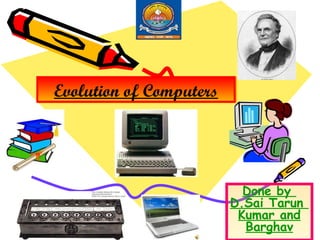
Computers power point presentation
- 1. Evolution of Computers Done by D.Sai Tarun Kumar and Barghav
- 2. Manual Calculating Devices Abacus and Napier’s bones are examples calculating devices. Abacus of manual Abacus is used as the ancient counting board which is used in Mesopotamia around 3500 BC. The modern abacus probably originated in 15 th century in China. Abacus is used for calculation which is consistedof pitted boards with pebbles or beads. Napier’s bones This calculating device was invented by John Napier in 17 th century. Napier’s bones are number rods that can be used for multiplying a long number by a
- 3. mi-Automatic Calculating Devices Pascal’s adding machine (Pascaline) (1642): One of the first semi-automatic mechanical devices, the Pascaline , was developed by Blaise Pascal. This brass rectangular box had eight movable dials to add sums up to eight digits long. Staffelwalze(the step reckoner)(1671): German mathematician and philosopher Gottfried Wilhelm von Libniz developed the Staffelwalze , which was an improvement over the Pascaline. The Staffelwalze allowed the user to add, subtract, multiply, and divide.
- 4. Jacquard’s loom(1801): Joseph Jacquard devised a mechanical loom, called Jacquard’s loom, which made weaving complex patterns a lot easier. The device used instuctions stored on a punched card to control the movement of threads. Difference engine(1822): English mathematician Charles Babbage, often called the ‘father of computer’, proposed a macine called difference engine. Analytical engine(1832): Charles Babbage proposed another machine, the Analytical engine, which had the basic elements of a modern general-purpose computer.
- 5. Electromechanical Calculating Devices The tabulating machine and Harvard Mark1 are examples of Electromechanical Calculating Devices. Tabulating machine(1887): American inventor Herman Hollerith invented the tabulating machine, which used punched cards for for storing and processing information. In 1890, Hollerith’s machine wasused to process data for the US census. In 1896,Hollerith founded the Tbulating Machine Company, which, after a series of mergers, eventually became International Bussiness Machines(IBM) in 1924.
- 6. Harvard Mark1(1944): American Computer engineer HowardH. Aiken devised the IBM Automatic Sequence Controled Calculater or Harvard Mark1. It was used for creating ballistic charts for the US Navy. Though slower in comparison to modern computers(taking about 3 to 4 seconds per calculation), it could perform basic arithmetic as well as more complex calculations. Electronic Computers Electonic computers are classified into various generations on the basis of the difference in technology. Each of these generations
- 7. First-generation Computers First-generation computers used vaccum tubes. Some of these are discussed below. Atanasoff-Berry computer(1941): The Atanasoff Berry Computer (ABC), built by John Atanasoff and Clifford Berry. Z3(1941): The Z3, developed by German engineer Knrad Zuse, was used in designing airplanes and missiles. Colossus(1943): The colossus computers were made by the British to decode German messages during World War2. ENIAC(1939-1946): The Electronic Numerical Integrator and Computer(ENIAC), developed by John Mauchly and J.PresperEckert, was the 1 st general –purpose digital computer. It was a huge machine, weighing about 30 tons. EDSAC(1947-1949: Electronic Delay Storage Automatic Calculator EDSAC(1947-1949 (EDSAC) was designed by Professor M.Wilkes of
- 8. EDVAC(1949):Electronic Discrete Variable Automatic EDVAC(1949): Calculator (EdVAC), developed by John Mauchly and J.Presper Eckert, was the successor of ENIAC. It could hold both a programand data in its memory. UNIVAC1 (1951):Universal Automatic Computer1 (1951): (UNIVAC) was one of the first commercially available computers. Second-Generation Computers(1954-1959) Second-Generation Computers were based on transistors.Model 604, IBM 1401, and IBM 1620 are a few examples of second-Generation computers. Third-Generation Computers(1959-1971) Third-Generation Computers were based on integrated circuits. An integrated circuit
- 9. IBM’s 360 series and 370 series computers are examples of Third-Generation Computers. Forth-Generation Computers(1971-Present) Forth-Generation Computers are based on microprocessors.IBM’s personal computer (PC) and Apple’s Macintosh are examples of Forth-Generation Computers.
